h4ppy.com - Christian's life and travels
'Work to live' is the credo, so I saved up enough cash and went wandering again in early 2006. This time it was 2 months in South East Asia and 1 month in the Sahara, including a solar eclipse. Now that I'm back, I hope to keep the blog fresh with whatever crosses my mind at the time. I hope you find h4ppy.com an interesting, and perhaps inspiring, read.
Monday, February 20, 2006
Friday, February 10, 2006
The good old days
I'm back in KL at the moment, and making the most of Harvey's broadband and the rainy day outside. I have now posted all the old emails recovered from my previous travels in Central Asia and the Middle East. Use the Archive links on the bottom-right of all the pages, or the links below, to relive those glorious days. I'm still missing the first email from my Central Asian travels - it's called "Spike, Bob and Barney" and was sent in late August or early September 2002, so please take a look through your email archives if you're a well organised data hoarder like Alex and Ralf.
September 2002 - Uzbekistan and Turkmenistan
October 202 - Turkmenistan to the Middle East including my time in Turkmenistan, Azerbaijan, Georgia, Turkey, Syria and Lebanon.
November 2002 - Middle East and Egypt including Syria, Jordan and my trip up the Nile and back again in Egypt.
Kek Lok See temple, Penang
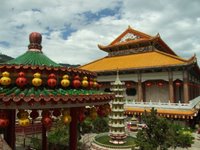 Outside the temples.
Outside the temples.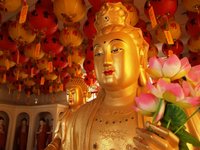 Inside one of the temples.
Inside one of the temples.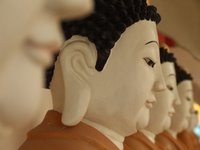 Rows and rows of statues bought with donations from the faithful.
Rows and rows of statues bought with donations from the faithful.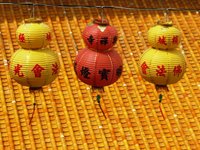 New Year's lanterns hang all over the complex.
New Year's lanterns hang all over the complex.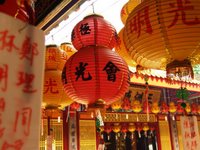
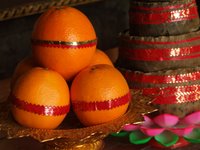 Offering in the temple.
Offering in the temple.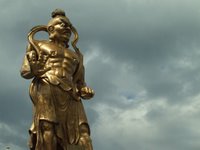
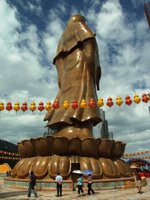 The central statue of the Guan Yin Bodhisattva (the Bodhisattva of Compassion or 'Goddess of Mercy'), it is 120 feet tall - the largest such statue in the world.
The central statue of the Guan Yin Bodhisattva (the Bodhisattva of Compassion or 'Goddess of Mercy'), it is 120 feet tall - the largest such statue in the world.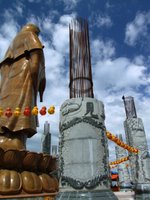 They are building six pillars around the main statue - they will each be 200 feet tall when they are completed, then topped with a roof (see below for sketch). At the moment, the next segments of the pillars are lying around the site, still with their Chinese shipping tags.
They are building six pillars around the main statue - they will each be 200 feet tall when they are completed, then topped with a roof (see below for sketch). At the moment, the next segments of the pillars are lying around the site, still with their Chinese shipping tags.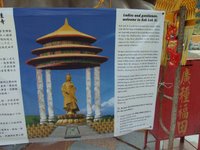 Artist's impression of the completed structure. Does not look particularly stable to me, but I gave up Structural Engineering in 1997, so don't ask me...
Artist's impression of the completed structure. Does not look particularly stable to me, but I gave up Structural Engineering in 1997, so don't ask me...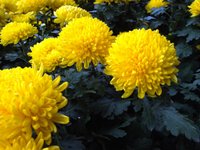 Chyrsanthemums in the temple gardens.
Chyrsanthemums in the temple gardens.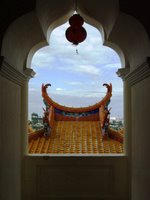 View from inside the main pagoda on the complex.
View from inside the main pagoda on the complex.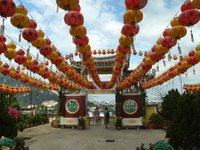 Leaving the temple (that's Harvey in the gateway)
Leaving the temple (that's Harvey in the gateway)Khoo Kongsi (Khoo clanhouse in Penang)
Chinese immigrants moved to Penang in waves. As anyone would do on arriving in a new and strange city they sought familiar, friendly, faces. This process was formalised by the creation of clan houses, based around families, hometown or trade. When a new member of the family (or from the same hometown, etc) arrived in town they looked up the relevant clanhouse and plugged themselves into the local network.
We saw similar houses in Hoi An (Vietnam) based mainly around profession. The ones in Penang are mainly based on region or family, and one of the most impressive houses is the Khoo family house.
The original house burned to the ground when it was struck by lightning and this was taken as a sign of the anger of the gods. The house was then rebuilt in a less ostentatious style so as not to arouse the gods' jealousy. If you ask me it's still pretty plush (if this is 'plainer' than the original, the original must have been quite a sight), but it hasn't been struck again, so they must have got the balance right.
Inside there are shrines to the ancestors, plaques citing members of the family with university degrees and a genealogy that traces the family back to the original Mr Khoo. One interesting touch is that there is a fifty word family poem and each the children (sons?) of each generation get the next word in the poem as their middle name (ie. people from the 3rd generation have the 3rd word of the poem). A nice idea, but probably works much better in Chinese than in English since I don't think they have (m)any prepositions (so nobody called 'the', 'a' or 'of').
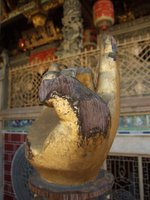
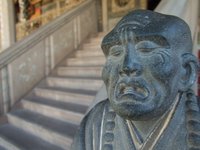
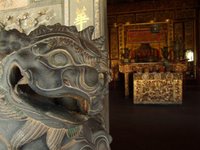 Various statues look out from the house.
Various statues look out from the house.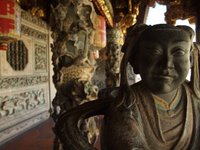
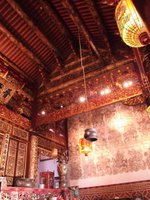 If this is less grand than the original, with its gold leaf and floor-to-ceiling murals, I can only imagine what the first one looked like...
If this is less grand than the original, with its gold leaf and floor-to-ceiling murals, I can only imagine what the first one looked like...
Penang City
After the highs and lows of the journey from Somosir Toba to Penang, I am delighted to say that we had a great time in Penang itself.
This is Harvey's hometown, and he has been carping about the best food in the world for so long that we were both looking forward to filling our stomachs. However, Harvey's favourite haunts were all shut - something to do with being close to Chinese New Year - so we had to settle for second best (which was still great). Noodles form the base, then you might get anything from wantons to cubes of congealed blood starring in the dishes, with a supporting cast of chillis, mushrooms and seafood. As well as the food, the hawker centres also make some of the best apple juice I've ever tasted. All it was missing was a dash of gin...
High point was breakfast with one of Harvey's local friends - oodles of noodles, chilli and seafood all before 9am! Low point was me losing my watch (I've no idea how). I'll post photos of the city here and then follow up with some pictures of the Khoo clanhouse and Kek Lok See temple.
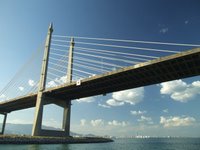 The bridge from Penang island to Butterworth on the Malaysian mainland. It's 13.5km long and the third longest bridge in the world - it's big, practical and photogenic!
The bridge from Penang island to Butterworth on the Malaysian mainland. It's 13.5km long and the third longest bridge in the world - it's big, practical and photogenic!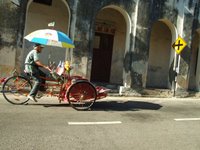 Street life - a Rickshaw rolls by, a parasol shading the heat of the day.
Street life - a Rickshaw rolls by, a parasol shading the heat of the day.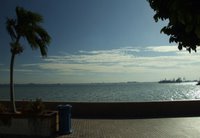 Looking across from near the town hall to the docks in the distance.
Looking across from near the town hall to the docks in the distance.Penang island was Britain's first trading post in South East Asia, hence the British names like 'Georgetown' and 'Butterworth'.
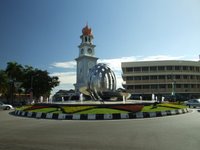 The Victorian era clocktower (built to mark the Queen's jubilee) looks down on the somewhat more modern sculpture in the centre of the traffic roundabout.
The Victorian era clocktower (built to mark the Queen's jubilee) looks down on the somewhat more modern sculpture in the centre of the traffic roundabout.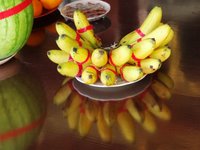 Offerings in a Chinese temple.
Offerings in a Chinese temple.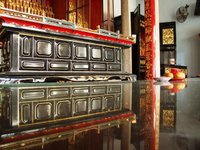 Reflecting on life, in the temple.
Reflecting on life, in the temple.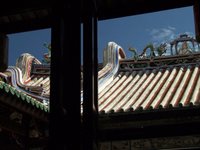 Inside the temple, looking out.
Inside the temple, looking out.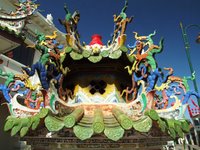 Decorations outside a different temple, this one near Armenian St
Decorations outside a different temple, this one near Armenian StThursday, February 09, 2006
Executive Class Travel
I drift into a drowsy non-sleep. The gentle rocking of the minibus and warm air assist this endeavour. The potholes do not. As I close my eyes I become more aware of the sounds around me: the rattling windows; what I can only describe as Indonesian Abba blaring from the speakers; the coughing fits of the woman in the corner seat.
We had chosen the Executive option for our return journey to Medan from Parapet on the shores of Lake Toba. Coming the other way we had taken the local 'big bus' - and spent 4 hours in baking heat slowly stewing in our own sweat, and the sweat of others (like the woman next to me who fell asleep with her sweaty brow on my shoulder or her baby that used my lap for a pillow), crammed in to a space not nearly large enough for western legs and bathed in the pleasing aroma of second hand smoke from clove-enhanced local cigarettes.
Executive minibus was, therefore, our preferred mode of return (maybe an extra 2 dollars each, plus we would be dropped next to our hotel instead of at the out-of-town bus terminal). We paid our money, handed our packs to the man on the roof and clambered on board - myself on the back seat and Harvey a row in front. The seating configuration was four rows of four seats. My row of four seats had six passengers (including me). To be fair, though, I should point out that 3 of those six were children, sitting and lying across their parents in various, shifting, configurations. I was also pleased to see that Executive legroom was far more generous than on the big bus - about 2 inches more, which meant that, if I sat bolt upright with my bottom against the seat back my kneecap would just be touching the seat in front.
...
My skull ricocheted off the window it was resting against. Another pothole. I did my best to ignore the new dent in my head then felt a slightly prickly heavy tap on my shoulder. I half opened my right eye and met the gaze of the 5 year old child, who was staring up at me. I think he was watching to see how I'd react now that his father had fallen asleep with his head on my shoulder. I decided to let the sleeping dog lie.
Moments later I was released from the head, when the father burst into a coughing fit. Not a petite sneeze, but a real coughing fit. With gusto. And phlegm. I dozed on.
...
The bus was noticably slowing - I could tell because the gush of air coming through the open window next to me was no longer rushing with such force that it made breathing difficult - and I opened my eyes to see we were passing through a small town and picking up and dropping off passengers amongst the roadside stalls and houses. The scent of durian wafted into the bus from one of these stalls, but luckily the edge was taken off it by the smoke from the cigarettes being smoked by the passengers.
On again, past the town. Tree lined roads were alternately backed by fields, plantation forests and houses. I checked my watch: 4pm. We had been going for 1 1/2 hours - less than halfway. I scribble some notes (which I am now struggling to read) then try to go back to sleep.
...
The following day sees our 5 hour ferry trip from Indonesia to Penang in Malaysia (Harvey's home town). It was even more fun than the bus journey - ice cold air con, cockroaches scurrying across the walls, an odd Chinese horror film about vampires (that looked like they were throwing up yoghurt when they were killed) and my own personal sea sickness. I'll save you the gory details, though.
We're now in Malaysia (truly Asia) and extra-grateful of small luxuries. Like tap water you can brush your teeth with and hot showers (with regular water pressure no less). Harvey's been carping on about the stunning food here, so I look forward to fattening myself up a bit before my imminent return to the cold, dark, British winter.
Thursday, February 02, 2006
Images of Boro Budur and Parambanan
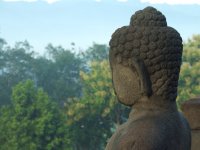 The lower terraces have numerous Buddha statues, each looking out over the lower terraces and surrounding landscape.
The lower terraces have numerous Buddha statues, each looking out over the lower terraces and surrounding landscape.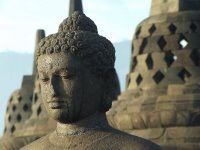 A buddha without a stupa (a de-stupified buddha?).
A buddha without a stupa (a de-stupified buddha?).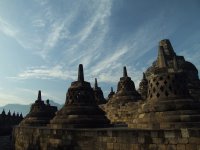 The upper terrace, with its bell-shaped stupas. Each used to contain a life-sized Buddha, but many of these are now broken or missing.
The upper terrace, with its bell-shaped stupas. Each used to contain a life-sized Buddha, but many of these are now broken or missing.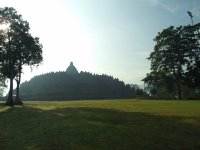 Boro Budur from a distance - it's immense.
Boro Budur from a distance - it's immense.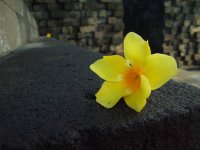 A flower resting on the terrace of worldly desires.
A flower resting on the terrace of worldly desires.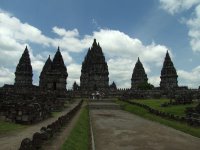 The approach to Parambanan.
The approach to Parambanan.From Nirvana to Heaven
How far is it from Nirvana to Heaven? About 60km if you're on the Indonesian island of Java.
The path to enlightenment
We rounded a corner in the approach avenue, the morning mist still hanging in the air less than an hour after sunrise. And stopped dead in our tracks.
Standing before us was the silent, tranquil, presence of Boro Budur. This is the world's largest Buddhist monument: built of more than 2 million stone blocks it takes the form of a giant mandala, 123m square at its base, and has levels to represent the world of desire (at the base, level 1), the world of forms (lower levels, 2-5) and the world of formlessness (upper levels, 6-8).
The world of desire is depicted by hundreds of panels depicting various acts of desire and human capriciousness - drunkeness, sloth, abortion/infanticide and bad acting (I kid you not) to name a few. However, the vast majority of these panels are covered up by plain stone blocks. Two theories exist - either they were covered up because they represented bad acts, or it was an ancient patch job with the extra blocks used to hold up the building which started to sink into the soft ground as soon as construction was completed.
Climbing through the square levels of the world of forms (the pilgrim's path would have you walking clockwise around each level in turn, slowly climbing to enlightenment) you pass panels depicting the life and times of Siddharta on the second level and then the other incarnations of Buddha (and his followers?) on the others.
And then you reach the world of formlessness and the landscape changes. No longer square terraces, but circular ones (without beginning or end). No more carved panels (there are no forms in the world of formlessness) only 6 dozen bell-shaped hollow stupas arranged in rings and each containing a (ruined) life sized statue of Buddha. The outer ring has diamond shaped (unstable) holes through which you can see the Buddhas inside, the next has square (stable) holes and the topmost stupa has no holes (it is infinite).
All in all, a traquil and beautiful place, with very few visitors. Boro Budur stands testimony to the architectural ability, creativity and organisation of the Javanese - even as far back as 800AD. It's also hard to believe but soon after this enormous monument was completed, the official religion switched from Buddhism to Hinduism as the local families clashed and a new power took over in the region. Nearby Parambanan was built and Boro Budur was abandoned, then covered in ash when nearby Mt Merapi erupted. It lay dormant under the ash until it was rediscovered almost 1000 years later, in 1815, by Sir Thomas Raffles.
Back to heaven
Actually, I'm not entirely sure that Parambanan is meant to be a representation of Heaven/Mt Meru (like Angkor), but it is definitely collosal. Three enormous main temples dedicated to Shiva, Vishnu and Brahma each have a smaller paired temple, all arranged in a central courtyard. Surrounding these are the remains of more than 200 other temples. Like Angkor Wat, each of the temples is a work of art impressive in scale as well as detail. The three main temples are more than 40m tall and covered in intricate carvings, often depicting scenes from the Ramayana. Photos to follow!
Wednesday, February 01, 2006
Alex to the rescue
Perhaps it's a Franco-German competition thing. In response to Ralf's heroics, Alexandra (my French friend) has managed to find the other half of my old emails - September and October 2002, covering everything from Uzbekistan to Turkey.
I think there's only one email missing now - the unforgettable tale of Spike, Bob and Barney (my first night in Uzbekistan).
I'll put copies of these old messages up on the site when I get more time (perhaps from the shores of Lake Toba, in a few days' time) and put links to them here.
Thank you, Alex, this is the perfect early birthday present! I hope you all enjoy reliving my old adventures and experiences as much as I do.


